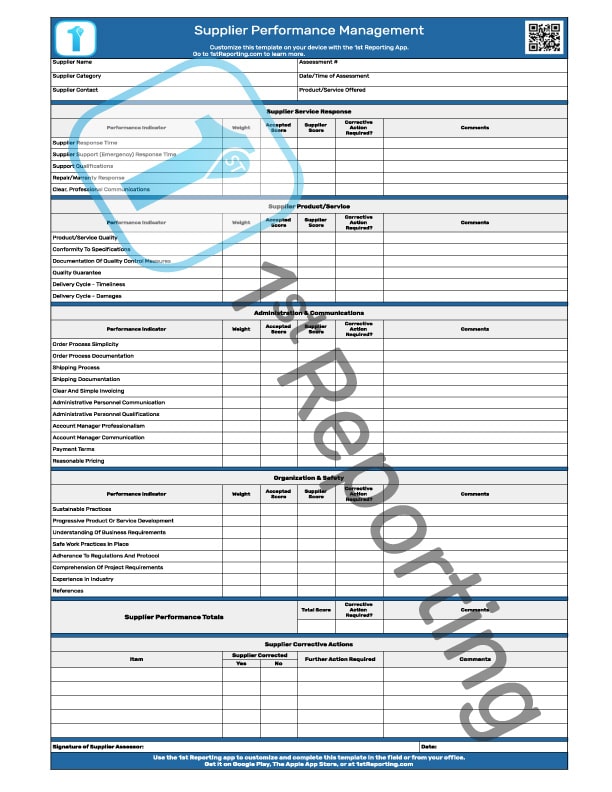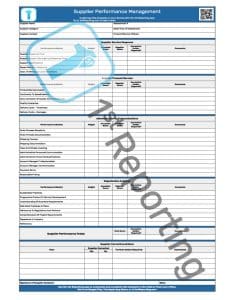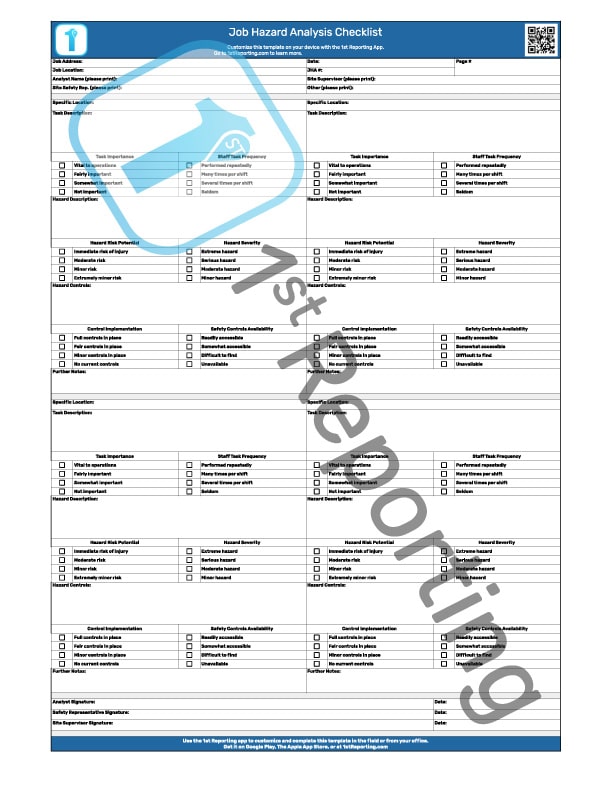Analyzing your supplier’s performance is necessary for proper supply chain management and evaluation. In fact, without appropriate performance analysis via a robust Supplier Performance Management Template, your company might be left in trouble should a supply chain disruption event occur.
A Supplier Performance Management Template is used to analyze and qualify a supplier’s ability to deliver services or products effectively. The form uses scoring and a point weight system to quantify the vendor’s key performance metrics to determine their overall effectiveness.
Using our Supplier Performance Management Template will make supplier evaluation easy and help you with corrective actions as they become a requirement. You need to download and print the template, and you’re ready to go. However, we’ve got some great tips to help you with effective completion, so read through our guide and find out how you can make your supplier performance process a breeze!
Included In The Supplier Performance Management Template

According to Geodis’s survey of KPIs for supply chain managers, 40% valued daily performance as the most popular of key performance indicators. Using our SPM Template (Supplier Performance Management), you’ve got the right tool in hand to determine your supplier’s score for their daily performance.
Comprised of seven sections, the Supplier Performance Management Template is a complete tool for analyzing and documenting your supplier’s KPIs. The following is a brief explanation of the seven sections of the SPM Template.
- Administrative
- Supplier Service Response
- Supplier Product/Service
- Administration and Communications
- Organization and Safety
- Performance Totals
- Supplier Corrective Actions
Administrative
Similar to so many other reports and audit templates, the Supplier Performance Management Template includes an administrative introduction that provides information such as:
- Supplier Name
- Supplier Category
- Supplier Contact
- Assessment Report Number
- Date/Time of Assessment
- Product/Service Offered
These data points allow for a quick snapshot to see the essential information regarding the supplier and an intelligent way of adding a filing system via an assigned audit number.
Supplier Service Response
The Supplier Service Response section of the template focuses on the supplier’s response times. These times include their general response time, emergency response time, repair/warranty response, and overall response communications.
Supplier Product/Service
One of the essential aspects of supplier evaluation is assessing the product or service itself. This section of the SPM Template focuses on just that – the product or service. It pertains to quality, conformity of specifications, and the delivery cycle.
Administration and Communications
In business, there is a saying: “He[she] with the best paperwork wins.” Ergo, you will want to ensure that your suppliers maintain proper paperwork. That paperwork must reflect a symbiosis with your organization’s needs, or it won’t be of much value.
The administration and communications review of a supplier ought to include a review of their documentation, ordering, and invoicing processes. Our section also consists of the qualifications of the account manager, and administrative personnel and even deals with payment terms.
Organization and Safety
A supplier’s organization might stand for something (or not) that conflicts with your organization’s views or brand. To stay out of politics, we’ve included sustainability practices, product or service development, and standard safety practices as KPIs within the Organization and Safety section of the Supplier Performance Management Template.
Performance Totals
No evaluation or supplier audit is complete without a performance total. The minor section approaching the end of our template includes a place to add a sum of the supplier score. Additionally, there is a note and corrective action check box for fast performance evaluation result communication.
Supplier Corrective Actions
Most suppliers might have great systems in place, but many also have room for improvement. When a supplier meets the requirements to work with, but falls short in certain areas, the Supplier Corrective Actions section steps into play. After the supplier audit, you can document specific corrective actions within this section of the document for reference when communicating with the supplier. However, there are many more great things you can do than talk to your supplier about how to improve. Let’s look at some of the best practices for utilizing an SPM Template in the following section.
How To Use The Supplier Performance Management Template
Once you have downloaded the supplier performance management template, it is essential to understand how to use it. The first step is to gather all the information you need for the supplier evaluation. It includes data from previous performance reviews, supplier quality audits, and customer complaints.
Next, you should review the supplier performance indicators included in the template. These indicators will help you evaluate the supplier’s performance in critical areas. After reviewing the indicators, you should score the supplier on each one.
Finally, it would be best if you documented any corrective actions that are needed. You can then communicate these actions to the supplier. Supplier performance management can be difficult, but using a template can make it easier.
Questions About Supplier Performance Management Answered
What are the key characteristics of a supplier evaluation survey?
When it comes to supplier performance management, there are a few key characteristics that any evaluation survey should have. These include using key performance indicators (KPIs) and corrective actions.
The use of KPIs is essential for any supplier evaluation survey. KPIs allow you to measure the supplier’s performance in specific areas. You can then use this information to make informed decisions about whether or not to continue doing business with the supplier.
Standard performance indicators are also essential for evaluating suppliers. They provide a more detailed look at the supplier’s performance in specific areas. This information can help you ascertain a supplier’s ability to meet your organization’s requirements.
The final characteristic of a robust supplier evaluation survey includes corrective measures. When we find inadequacies in a supplier’s processes, products, paperwork, or service, it is best to communicate these inadequacies to allow the vendor a chance to correct the issues.
What is the best way to score a supplier?

The best way to score a supplier is to use a supplier performance management template. This template should include key performance indicators (KPIs) and corrective actions. Using this template, you can evaluate the supplier’s performance in specific areas and take corrective action if needed.
Which is the most common method of supplier evaluation?
A supplier performance management template is the most common method of supplier evaluation. KPI stands for key performance indicators, a set of quantifiable measurements that offer insight into supplier performance, including things like on-time delivery completion, customer satisfaction, and days with no product defects – all based on predetermined goals.
These KPIs are identified at the beginning of the contract period. They can be used by either the supplier or their customer to measure success periodically during production cycles.
Considerations when choosing a supplier may include price points, materials sourced from sustainable sources, and free trade agreements (to ensure their marketability).
How do you evaluate foreign suppliers?
When considering a supplier, often, the supplier is from a foreign country. There are a few things to consider when trying to evaluate a supplier from another country.
The first thing to consider is the political and economic stability of the supplier’s home country. It will be essential in assessing the risk of doing business with that supplier. Another thing to consider is how closely the supplier’s home country aligns with your company’s values. If there are significant discrepancies, it could be challenging to do business together successfully.
Another essential factor to look at is how well the supplier communicates. Often, suppliers from other countries don’t speak English very well. It can make communication difficult and can lead to misunderstandings.
A Better Solution For Supplier Performance Management?

We’re happy you’ve decided to take a look at our Supplier Performance Management Template today. However, what if we were to tell you that you could use a digital reporting application instead and save yourself ever printing anything?
Looking for a better way to document audits, incidents, and more?
Look no further than 1st Reporting. Our app is designed to make documenting and reporting more effortless than ever before. You can create the perfect form for your needs with customizable checklists, forms, and templates. And with our extensive built-in library of templates, you’ll be up and running in no time.
Our app is easy to use, but it also provides customizable notifications so managers can be made aware the moment a team member completes a report. Plus, the app can generate automated reports to allow for trend analysis. So why wait? Get started today with 1st Reporting and find out what so many other managers are excited about!





